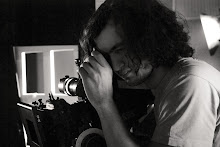
 Maysles brothers
Maysles brothersWhy
As a documentarian I happily place my fate and faith in reality. It is my caretaker, the provider of subjects, themes, experiences—all endowed with the power of truth and the romance of discovery. And the closer I adhere to reality the more honest and authentic my tales. After all, knowledge of the real world is exactly what we need to better understand and therefore possibly to love one another. It’s my way of making the world a better place.
How
1. Distance oneself from a point of view.
2. Love your subjects.
3. Film events, scenes, sequences; avoid interviews, narration, a host.
4. Work with the best talent.
5. Make it experiential, film experience directly, unstaged, uncontrolled.
6.There is a connection between reality and truth. Remain faithful to both.
 Some Do's and Dont's
Some Do's and Dont's• Hold it steady.
• Use manual zoom, not the electronic.
• Read as much of the PD 170 manual as you can.
• Read book or chapter in a photography book on how to compose shots.
• Use the steady device that’s in the camera.
• Never use a tripod (exception: filming photographs, for example).
• You’ll get a steadier picture the more wide-angle the shot. In a walking shot go very wide angle.
• Hold the beginning and end of each shot. The editor will need that.
• Use no lights. The available light is more authentic.
• Learn the technique but equally important keep your eye open to watch the significant moment. Orson Welles: “The cameraman’s camera should have behind its lens the eye of a poet.”
• Remember, as a documentarian you are an observer, an author but not a director, a discoverer, not a controller.
• Don’t worry that your presence with the camera will change things. Not if you’re confident you belong there and understand that in your favor is that of the two instincts, to disclose or to keep a secret, the stronger is to disclose.
• It’s not “fly-on-the-wall”. That would be mindless. You need to establish rapport even without saying so but through eye contact and empathy.

The Maysles Brothers and Charlotte Zwerin
Referred to as The Maysles Brothers, Albert and David were among the first documentary film-makers to make non-fiction feature films. In the early sixties Albert had worked with the classic documentary team assembled by Robert Drew which included Richard Leacock and Don Pennebaker and made such films as Primary, and Yankee No. His first film made with his brother David was Showman (1963), a portrait of producer Joe Levine, followed by What's Happening? The Beatles in the USA (1964) and Meet Marlon Brando (1965). But brilliant as these early films were, the Maysles Brothers' breakthrough film was Salesman (1968) which was edited by Charlotte Zwerin who had edited their earlier film With Love From Truman (1966). Charlotte’s work was so crucial to shaping this film and Maysles Films' subsequent epic rock and roll classic Gimme Shelter (1970), that it was clear that editors as gifted as Charlotte are in fact documentary co-directors. Charlotte joined Albert and David as co-filmmaker on the later Christo films Running Fence (1978) , and Islands (1986) and co-directed with Albert and Susan Froemke Horowitz Plays Mozart (1987). Charlotte Zwerin’s own films include portraits of Willem De Kooning, Ella Fitzgerald, Arshile Gorky and the jazz classic Thelonius Monk: Straight No Chaser.
http://www.mayslesfilms.com

Gimme Shelter
Aquí al parecer los magos son los Rolling Stones, pero la verdadera magia de este documental esta en el ojo de los Maysles Brothers. Quienes en su película relatan una gira de esta conocida banda de rock por estados unidos en el 69 principalmente el concierto gratuito que dieron con Jefferson Airplane en el norte de California en el Altamont Speedway, tan solo 4 meses después de Woodstock.

Este documental se asemeja en una parte a el documental de Woodstock pero, realmente este es el documental que marco todos los parámetros que conocemos hoy en este vertiente del cine que es el documental de rock.
El contexto social durante el cual ocurre es importantísimo, y la zona mas, ya que California y sobretodo cerca de San Francisco fue la meca la cultura psicodélica. Era una juventud llena de ideales y en ese momento histórico chocan 2 grupos culturales como lo son los hippies con los Hellangels que estaban encargados de la seguridad del evento.

Luego podemos observar a los Rolling Stones viendo el material recopilado de la gira en la sala de edición, lo cual es un momento maravilloso ya que vemos como la visión de los documentalistas y las de los músicos se encuentran, provocando un momento mágico del cine.

No hay comentarios:
Publicar un comentario